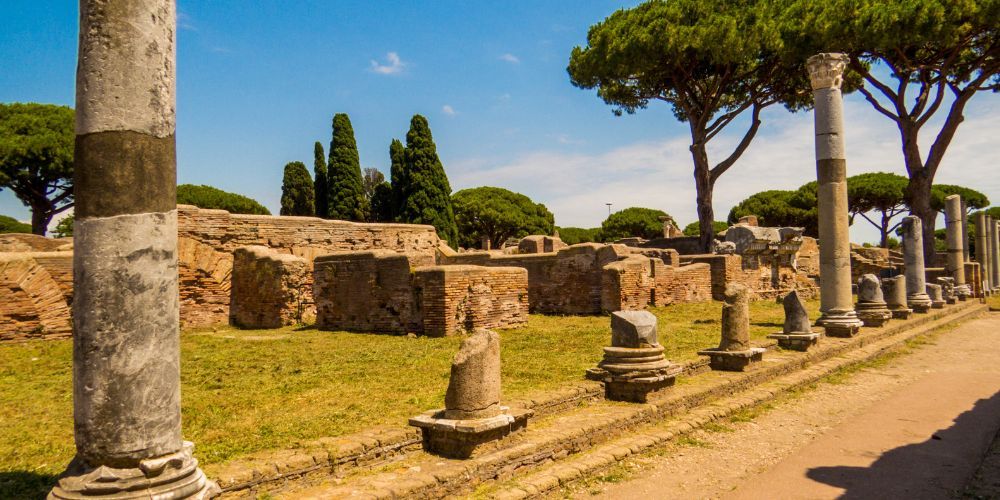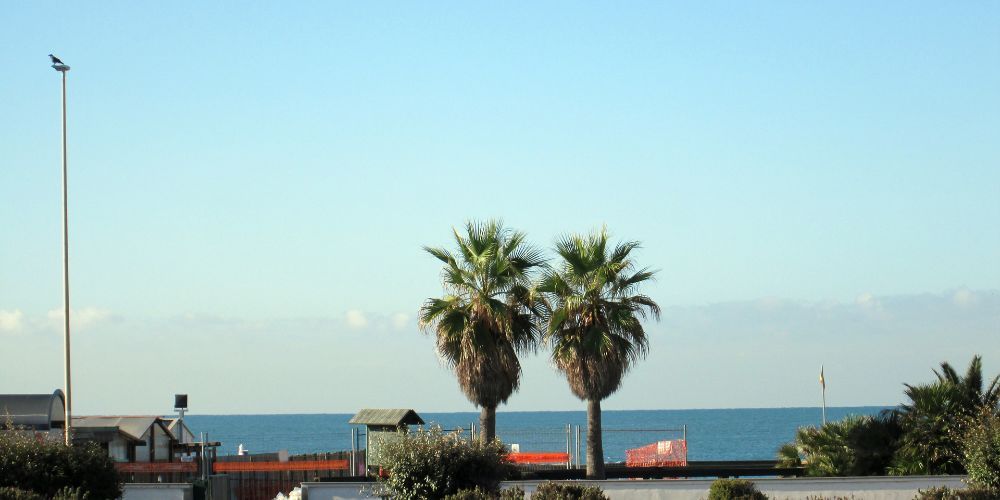Ostia, a historic jewel on the Tyrrhenian coast, stands as a fascinating destination within easy reach of Rome. With a history rooted in antiquity, this location offers a unique combination of well-preserved archaeological remains and wide sandy beaches overlooking the Tyrrhenian Sea. But how to get to Ostia? Doing it is surprisingly easy thanks to a variety of transportation options, making this location an ideal choice for those seeking an escape from the hustle and bustle of the capital city without having to make long crossings.
The ancient ruins of Ostia Antica, once a thriving trading port of the Roman Empire, stand as silent witnesses to the glorious past. Visitors can stroll among the intricate mosaics, imposing temples and ancient theaters, breathing in the atmosphere of a bygone era. In addition, Ostia's long, well-maintained beaches offer a serene haven where visitors can enjoy moments of relaxation, sunbathing or soaking in the crystal-clear waters of the Tyrrhenian Sea. Through its streets paved with history and enchanting coastal atmospheres, Ostia invites visitors to immerse themselves in a journey between past and present, providing unforgettable experiences. So, let's discover together how to get to Ostia.

Why getting to Ostia?

Ostia, with its unique combination of fascinating history, magnificent ancient ruins, and enchanting beaches, presents itself as a must-see destination for anyone wishing to explore the cultural richness of ancient Rome and enjoy relaxing moments on the Tyrrhenian coast. The ruins of Ostia Antica, once a thriving trading port, offer an extraordinary immersion into the past, with their well-preserved temples, theaters, and mosaics that tell the story of the Roman Empire. This archaeological site offers an unparalleled opportunity to walk among the same paths that were trodden by the ancient Romans, living an authentic and unique experience.
The seaside resort of Ostia also provides an idyllic retreat along the Lazio coast. The wide sandy beaches offer a relaxing atmosphere and the opportunity to enjoy sunny days, take long walks along the shoreline or dive into the crystal-clear waters of the Tyrrhenian Sea. The diversity of activities Ostia offers is a key element of its appeal, allowing visitors to balance moments of cultural exploration with moments of pure relax.
The Medieval Village of Ostia Antica, with its picturesque narrow streets and buildings with striking architecture, is a dip into the medieval atmosphere, offering a different perspective than the Roman ruins.
Moreover, Ostia's proximity to Rome makes it an easily accessible destination, allowing travelers to enjoy a day trip from Rome or extend their visit to fully explore all its facets. The unique atmosphere that pervades Ostia, with its mixture of history and coastal landscapes, offers a complete and engaging experience that leaves an indelible impression in the memories of those who decide to visit. In short, Ostia presents itself as a treasure that combines past and present, inviting anyone to discover its timeless charm.
Finally, the many dining options along the waterfront, with restaurants serving traditional Italian cuisine, allow visitors to enjoy local delicacies while enjoying spectacular views of the sea.
Find out how to visit Ostia AnticaHow to get to Ostia form Italy's biggest cities

Reaching Ostia is a journey that can be undertaken from various parts of Italy, offering several transportation options to answer the question of how to get to Ostia. From Milan, a viable solution is the high-speed train, which connects the two cities quickly and efficiently. Roma Termini station is the ideal arrival point, from which one can easily take the metro or the Roma-Lido train to Ostia.
From Tuscany, the A1 highway offers a direct connection from Florence to Rome, allowing travelers to enjoy the picturesque Italian landscape en route. Once in Rome, local transportation options, such as the metro or train, are available to reach Ostia.
For those still wondering how to reach Ostia from Naples, high-speed rail is again a viable option, taking passengers to Rome from where they can continue their journey to the Lazio coast. Alternatively, the A1 highway is an easy route for those who prefer to drive to Rome and then take public transportation to Ostia.
In conclusion, regardless of the region of departure, the diversity of transportation options offers anyone the opportunity to answer the question of how to reach Ostia in a practical way that suits their travel preferences.
Getting to Ostia from Rome: train, metro or car?

Reaching Ostia from Rome can be a pleasant and convenient experience, considering several public and private transportation options. One of the most efficient alternatives is the railway network, particularly the Roma-Lido line. The recommended starting point is the Porta San Paolo station, located near the striking Cestia Pyramid. Trains on the Roma-Lido line are frequent and offer a direct connection to Ostia, allowing you to reach your destination in about half an hour, with the advantage of being able to admire the urban and coastal landscape on the way.
For those who prefer to use the subway, the B line can be a convenient option. We recommend taking the metro to the Magliana stop and from there continuing the journey to Ostia using the Roma-Lido train. This route offers greater flexibility, allowing travelers to tailor the initial route according to their location in the city. The combination of metro and train offers a practical and fast alternative to reach the coast of Ostia.
For those who wish to explore the area more independently, the car option may be the ideal choice. By following the Via del Mare (SS8) southwest from Rome, you can reach Ostia in about 30 to 40 minutes, depending on traffic conditions. It is always advisable to check traffic information before setting off to ensure a smooth journey. The car also offers the freedom to explore the surroundings of Ostia, allowing you to discover places of interest along the way. Regardless of the means of transportation you choose, getting to Ostia from Rome presents itself as an affordable and rich experience to fully enjoy one of the closest coastal treasures to the capital.
Browsing through the options: reaching Ostia by public transportation

Reaching Ostia by public transportation is a smooth experience due to the variety of transportation options available. For those arriving by plane, Fiumicino Airport, located a short distance from Ostia, is the main entry point. From the airport, one can opt for a convenient bus service that connects Fiumicino directly to Ostia, offering an uncomplicated transfer.
Those who prefer the train can take advantage of train services connecting Rome to Ostia. Rome's Porta San Paolo train station serves as the starting point, from which frequent trains depart to Ostia Antica. This train trip offers not only a fast alternative but also the opportunity to enjoy picturesque scenery along the way.
For those who choose to travel by bus, the public transportation service is well organized between Rome and Ostia. Buses depart regularly from various stations in the capital, providing a convenient option for those who prefer a trip overland.
For those who opt for the autonomy of a road trip, Ostia is easily accessible via the SS8 highway, known as the Via del Mare. The route offers not only the flexibility of a trip on four wheels but also the opportunity to explore the picturesque Roman countryside along the way.
If you are in Rome and want to get to Ostia from the comfort of a cab, we at Visit Italy have the solution for you! Click the green button at the end of this paragraph to book your cab from Rome to Ostia and vice versa!
In conclusion, Ostia proves accessible from several directions due to its proximity to Rome and multiple transportation options. Whether one chooses to fly, travel by train, bus, or car, getting to this fascinating coastal resort is a convenient and opportunity-packed experience to discover its thousand-year history and natural beauty.
Find out how to get to ostia by taxiNavigating Ostia: tips on getting around within the city

As you immerse yourself in Ostia's vibrant atmosphere, it is essential to carefully plan your movements within the city to maximize your time and fully enjoy its many attractions.
1. Walking among the ruins: Most of Ostia Antica's major attractions are within walking distance of each other. Therefore, the best option for exploring the ruins is on foot. Wearing comfortable shoes, you can move easily between temples, theaters and ancient streets, capturing every detail without hurrying.
2. Bicycle rental: An alternative way to explore Ostia is to rent a bicycle. This option allows you to quickly cover longer distances, allowing you to explore not only the ruins but also the surrounding areas.
3. Local buses: For longer trips within Ostia and its surrounding areas, local buses are a practical option. Check schedules and stops to plan your commute to suit your needs.
4. Rental car: If you want more flexibility and autonomy, renting a car may be the best option. Keep in mind that while Ostia Antica can be comfortably explored on foot, a car may prove useful for trips to the beaches or the Litorale Romano Natural Oasis.
5. Cab services: Taxi services are available and can be useful for faster travel or to reach specific places conveniently.
6. Urban mobility apps: Use urban mobility apps that can provide real-time information on bus and train schedules and walking tips.
By following these tips on how to get around within Ostia, you will be able to explore the city easily, allowing for a thorough discovery of its historical and natural riches.
About the author
Written on 20/12/2023



Genny Lacava
Thanks to this guide of ours you will know all the ways to get to Ostia, the pearl of the Roman coast full of culture, art and entertainment.